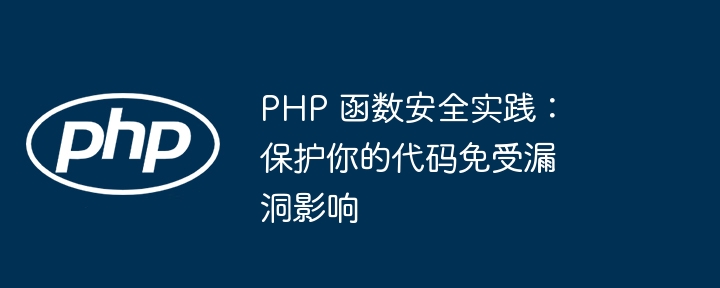
PHP function security practices are critical to protect your code from vulnerabilities. Best practices include using type hints to force functions to accept specific types of input. Validate input to ensure validity. Escape output to prevent XSS attacks. Restrict function permissions to prevent abuse. Take the file upload function as an example to verify the file type, size and move to the target directory. By following these practices, the security of your PHP functions will be greatly improved, protecting your code from potential vulnerabilities.

PHP Function Security Practice: Protect Your Code from Vulnerabilities
In PHP development, function security is crucial Important because it protects your code from security vulnerabilities. By following the following best practices, you can ensure that your functions are safe and trustworthy.
Using type hints
Type hints can help you catch errors and prevent accidental input. For example, you can force a function to accept only integers using the following type hint:
function add($a, $b): int
{
return $a + $b;
}Validate input
Always validate input accepted by a function. For example, you can use the filter_var() function to validate email addresses:
function send_email($email)
{
if (!filter_var($email, FILTER_VALIDATE_EMAIL)) {
throw new InvalidArgumentException("Invalid email address");
}
// 发送电子邮件代码
}Escaped output
When the function generates HTML or other output , the output must be escaped to prevent cross-site scripting (XSS) attacks. For example, you can use the htmlspecialchars() function to escape HTML output:
function display_message($message)
{
echo htmlspecialchars($message);
}Restrict function permissions
If you are creating a custom function , please restrict its permissions to prevent abuse. For example, you can use declare(strict_types=1) to enable strict type checking, or use the private access modifier to limit the visibility of a function:
declare(strict_types=1);
private function sensitive_function()
{
// 敏感代码
}Practical Case: File Upload
The following is a practical case that illustrates how to apply the principles discussed previously to protect the file upload function:
function upload_file($file)
{
// 验证文件类型
if ($file['type'] !== 'image/jpeg') {
throw new InvalidArgumentException("Only JPEG images are allowed");
}
// 验证文件大小
if ($file['size'] > 1000000) {
throw new InvalidArgumentException("File is too large");
}
// 移动文件到目标目录
move_uploaded_file($file['tmp_name'], 'uploads/' . $file['name']);
}By following these best practices, You can greatly improve the security of your PHP functions and protect your code and applications from potential vulnerabilities.
The above is the detailed content of PHP Function Security Practices: Protect Your Code from Vulnerabilities. For more information, please follow other related articles on the PHP Chinese website!